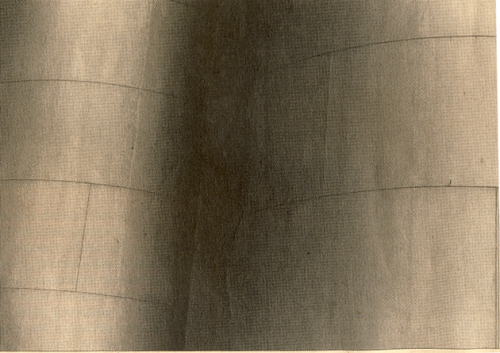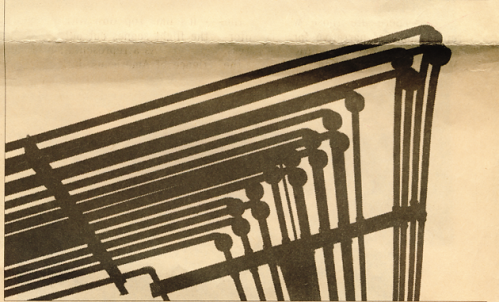Creative Play
The Game as Art, and the use of the Computer in its Realisation, Development and Promotion.
Someone, not considered worthy of inclusion in the Digital Dictionary of Quotations on my system, once described Chess as a work of art that every time he played, he saw from a different angle. The exaggerated reverence of a hobbyist attempting to elevate his pastime into something a bit more sublime perhaps - and without being able to remember any more about the person other than the gist of his quotation, I can only speculate - but nonetheless a valid, and potentially valuable, viewpoint, that hints at what is to my mind, a greatly underdeveloped potential art form.
I'm not sure how many involved in the arts would class the Game as art, from my own personal conversations I would suspect few. Generally it seems to be seen as a diversionary and basically trivial pastime that could never be considered to be addressing the lofty purposes of Art. But I would contend that the experience of game play, in its various different forms, has within it qualities that put to the uses of Art can express things in ways that are not possible within any other media.
A game articulates its relationship with the viewer with a specificity not available to other art forms, demanding an engagement and involvement with the subject matter that other forms of artefact can only hope for. Its forms are both actual and symbolic and in their specific and immediate relation to the viewer are given strength, clarity and expressivity.
Perhaps I should define what this 'Game' that I'm talking about is. I would call a game the submission to another set of rules than those by which one is normally bound and/or the taking on of other objectives to those which one usually follows. In either case the effect is to change one's personal environment, either by changing the ways in which one is able to move through it, or by changing the figurative direction in which one seeks to move through it and consequently encountering it in a different form.
Rules and objective are distinct entities that can be swapped and changed independently of each other. One could alter the object of the game of Chess to capture the opponent's Queen as opposed to their King without altering the rules of play in any way, similarly one could redefine the rules of movement and capture while still keeping the same objective of King capture.

A well chosen objective can throw an environment into relief. Kit Williams' `Masquerade', basically an art book, was transformed by also having hidden within it clues that would lead to actual buried treasure. The very act of seeking to find these clues, however far off the mark one actually was, significantly enriched the piece. Everything was given a new aspect, associations and connections, some logical, some mythical, emerging as they never would have had one simply browsed the book. An objective brings gravity into a system. Rather than drifting aimlessly through space, occasionally knocking into the bodies within it and bouncing off again, probably without even noticing, one is forced to contend with it. One has to learn to crawl, walk, run and eventually, perhaps, to build vehicles and drive on the surfaces of the planets fallen onto. Many a conceptual rule based art piece might be transformed from something eliciting an "oh really?" response, to something demanding and receiving a full understanding of its form when the viewer is forced to navigate it to reach a specific destination. Any number of different destinations might elicit this understanding, just as seeking to solve any one of a number of Zen koans can apparently lead to enlightenment.
Games are generally composed of two elements, which might be defined as the `Platonic' and the 'Manifest'. The Platonic content is broadly the rules and object of the game. In Chess: how the pieces move, how the game is won, the way the game works, its 'logic'. The Manifest is how the game actually appears to those playing it; what the board looks like, what the pieces look like, how they feel, what they are called, what the game is called, how it is perceived in its cultural context. One could say that the Manifest 'dresses' the Platonic.
As with rules and objective, these two elements are generally absolutely distinct entities, each able to exist independently without the other. A deck of cards, for example, has no specific game for which it is designed to be used, and card games can be translated so as to be played without the aid of actual cards, which in themselves have no need to look as they do or be called as they are. Spades, hearts, diamonds and clubs could equally well be clouds, bricks, cars and worries. Or whatever.

The relationship between these two elements has expressive potential.
The Platonic content of the game confers a meaning on the Manifest artefacts that they would not otherwise have, in a similar way to which the narrative content of a film affects the images within it. A chess piece assumes qualities of worth and power from its role within the game that it would not have were it just a solitary artefact.
Similarly the Manifest colours the Platonic. I once played a game of 'beach draughts'
which was given a new dimension when in the absence of other obvious distinguishing features in the local stone population, large stones were pitted against small. The discrepancy between the pieces' apparent strength and agility as one would suppose from their size, and their actual abilities within the game, gave the play a quality quite different from that to be had from the traditional black versus white. (I don't remember which side won)
As well as the expressive qualities of this relationship, the Platonic element in itself is expressive. An abstract system can find many reflections, both conscious and unconscious. In the same way that music and other abstract arts, express themes and relationships that may not in themselves refer to anything specifically, but are nonetheless expressing something of value, so with the abstract content of the game. In the Japanese game of Go, the object of which could be summarised as being to surround territory without being surrounded, the tension between the scale of one's ambitions, in how widely one stakes out of one's space with one's players, and their resultant vulnerability from being scattered too far apart from each other, is an abstraction of a principle that can be found in many of life's enterprises, one that many an over expanding business might recognise.
There is also an aesthetic to be appreciated in discovering the artefacts of the system as understanding of the game progresses. Games with relatively simple rules, the aforementioned Go and the strategic game Othello are examples, can, when pushed by competing players, throw up a variety of artefacts, albeit ones that can probably only be appreciated by players of the game, somewhat reminiscent of the way cellular automata, simple rule based artificial life programs running on a computer, produce artefacts that would be hard to predict.
Games can be representational or abstract.
Where a game is representational the Platonic element is modelled on the dynamic of the phenomenon/situation that is being represented. Taking this line some game developers will seek to ever expand the game so as to become more and more like 'the real thing'. As well as making the game extremely cumbersome it can result in a game composed of a pile of incidentals while the salient dynamic remains elusive. The distillation and ordering of underlying principles is a concern of both art and science; much drama and narrative seeks to strip away the incidentals and clearly show the underlying logic of a situation. The game provides a means of presenting these principles in action, but whereas a dramatist or storyteller can effectively shepherd the principles to drive events to his desired end, in a game they are left to get on with it by themselves. Watching how principles unfold autonomously provides a viewpoint and understanding of them not available from within other art forms.

With a functioning simulatory Platonic element one can experiment with changing the Manifest; are there other phenomena that work along the same principles? How do they appear when driven by them? Allegory and metaphor can be investigated in a dynamic form.
Though the game has often inspired artists, few have thought to use it as an art form in itself. Why is this?
The game's cultural perception and role may play a part in this. It should be noted that the game is generally a competitive affair. Much of the game's history and cultural perception is as a form of rutting display, an institution wherein players can 'prove their worth' and as such games might be seen as episodes in the wider game of socio-politics, providing an arena on which these minor dramas can be played out, without having much significant content in themselves.
In some games, 'race games' such as Snakes and Ladders, darts, golf etcetera, the competitive element, within the play itself, can be pretty much incidental; one sees which player can best negotiate the environment put in their way, without any interference from other players. In others the presence of a competing player or players is crucial; the presence of a resisting will creates and animates what would otherwise be a dead environment that the player must negotiate. Most of the more interesting traditional games rely on this factor.
Though much drama and narrative is based around conflict, and much of the qualitative experience of play can justifiably consist of the same, as a theme it can tend to drown out some of the other subtler elements that may be present. Nigel Short, the British Chess Master, talks of the game being about totally crushing one's opponent as a human being; is this 'art'?
Games are not the most accessible of media; rules of play must be learnt before they can be appreciated and often a certain level of mastery must be acquired before finer aspects are appreciated. It may also require a certain element of faith in the existence of those finer aspects to think it worthwhile to persist in developing the mastery to find them.
To design a good game is not easy. Understanding and control of fairly formal elements, the uses of which are likely to be somewhat alien to those familiar with working in the other arts. Balancing elements of accessibility - how easy it is to understand the rules - , cumbersomeness - how much of an effort, both mental and physical, it is to carry out the rules - , complexity - how complicated the game becomes and how penetrable or impenetrable it is to understand and gain command of - , and the physical logistics of game play - how asy or fiddley it is to manipulate the pieces, can the board fit inside the average living room, are all parts of it accessible without knocking over or crushing other pieces.
A lot of design and refinement has to be done through experimentation. Without fairly profound mathematical expertise predictions cannot be made on how a game will turn out before it is actually played and played a good few times. Quite often games will transpire to be 'non games' in that some technique or strategy may emerge that will decide the game at an early stage, sometimes reducing the game to the outcome of the toss of the coin to decide the starting player, or to interminable stalemate.
To test games while in development requires prototypes to be constructed and reconstructed and players to be found to test them out; all of which can be choresome.
All these obstacles to development can be addressed in varying degrees by the Computer.
The Computer can act as a powerful design aid. Whereas in the past physical prototypes had to be created these can now be built within the Computer's virtual world where material is a lot more flexible than in the physical world. Boards can easily be designed and redesigned to any specification. Counters? How many do you need? As for finding players to try out the game, the expanding community of the Internet provides an accessible pool of potential players to try it out in its different forms. A form of evolutionary development could be set up whereby the details of the game - the size of the board, the number and starting positions of the counters, etcetera - could mutate and depending on feedback from the players, hopefully evolve to an optimum form. This could be done automatically, with the effect that a basic game design could be released, with instructions for mutation and positive feed-back, into the Cyber Community, come back a year later and be picked up as a fully evolved Super Game. (It's just an idea.)
These ideas can help in traditional game development; games can be modelled and tested within the Computer environment then transferred to the 'real world' when their development is complete. But it is when games make their home within the Computer that things can really begin to take off.
Rule maintenance, previously the domain of the players or an umpire, can be taken over by the Computer. Complicated rules, such that the novice might have difficulty in knowing whether his intended move is legal or not, become more feasible when it is impossible to make an illegal move. The system could also provide guidance on this front.
Cumbersome rules requiring much working through and manipulation of pieces (though admittedly sometimes such rituals can be an important component of the quality of play) can be automated by the Computer, allowing for a complexity of game design that from a practical point of view could never be viable in a physical form.
Physical limitations disappear. Boards can be extended to any size and shape, without the traditional engineering and living room constraints. We are no longer bound by the Aristotelian convention of the single scene; any number of different boards can be jumped to and from with the maximum of ease. Pieces can be infinitely numerous and various, can sit anywhere they are placed without falling off or falling down (who needs gravity?), can have absolute accessibility and manipulatability.
Whereas previously games relied on competing human intelligences to give them their sophistication, now one of those intelligences can be replaced by a machine intelligence. This completely alters the combative significance of the game; it's no longer about two humans thrashing it out to prove one the better. Initially the symbolism may assume the form of Man versus Machine. My portable Chess Computer from a few years back has two tournament style clocks running on it, so the game is about whether I can think both better and also quicker than the machine I am playing against. It's still about which is the 'better being'. Though the anthropomorphic instinct is fairly strong it does not have to be deferred to; the role of the machine can change from one of competing intelligence to environment-creator, freeing the game from it's role as a combat zone to be able to examine a wider, perhaps more interesting area.
Experimenting with the Manifest element of the game is made easy with the Computer. Games can have different 'costumes' to dress their Platonic content (the popular blastem-up game of Doom has different costumes available; ogres from hell can be replaced by Bunnies from Duracell, for example). It might be nice to get different artists to design them. These can be swapped at will by the player or by some other dictate; perhaps they can just swap spontaneously at random intervals through the game. The appearance of the game could react to the state of play; chess pieces might appear increasingly dejected as their side weakens...

In games played over a network one game can assume multiple Manifest forms; with some ingenious 'costume design' one player might think they're fighting a barroom brawl with another player, who thinks they're involved in inter-Galactic warfare. Or in a non-combative form it might be possible to translate the conflict so that a player's success at negotiating an obstructive environment controls the degree of obstruction another player meets in another. Players might not be aware as to whether there's some kind of intelligence controlling the universe they're in, or whether the weather's being particularly cussed that day. It all comes down to if you believe there's a God and in what state you believe your Karma to be!
Another opportunity that the Computer offers is in the area of what might be loosely termed 'invention games'. Elements of engineering exist in traditional games; strategic elements can be designed and implemented in much the same manner as 'inventions' in the real world, expressing the same ingenuity and elegance. But whereas in the real world one can create machines that work by themselves under their own power, in the traditional game a human has to be, there, figuratively 'turning the wheel'. A game I was developing, 'Logigo', was based around the concept of logic-gates, the concept being that in the game one could built logic-circuits that could be used within the game to steer it to its desired end. Naively perhaps, this was originally developed as ; card and counter game, but, soon ran into the problems of cumbersomeness referred to earlier; gates and connections, all on separate cards, had to be numerous, and logical states, represented by reversible counters, all had to be changed by hand. The game was too slow and fiddley for the interest to develop and for any of the intended creative engineering to take place Transferred to the computer everything, becomes streamlined and some of the orig final concepts from when the game was conceived can be approached. In the virtual world any kind of component can be conceived and realised, and will work perfectly.
So will the evolution of the Game to art form occur? As the market matures, both in itself, and as its established base grow up, gets a bit fragile and loses its reflexes perhaps we'll see a move away from the speed obsessed games currently predominating and a move towards those of a more cerebral, creative nature.
The Game probably sits somewhere near or on the dividing line between C.P.Snow's `Two Cultures' of Art and Science, and may well be split unproductively along it. But they are signs that the two sides are tentatively drifting towards each other. Post Modernism in its universal appropriation call areas of culture, which incidentally includes a currently rather sexy looking Science, and in its nihilistic rejection of the signifier and consequent interest in structuralism and formalism, may help to give the art world the confidence and equipment it needs to examine and get to grips wit, the Game. Science also seems to be feeling a little bit cocky and looking around bit; who knows, it may decide to wander over and have a look at all that 'art stuff Sitting there, waiting hopefully on the ground below them, is the Game, waiting for some one to pick it up and nurture it, just a the IT tidal wave floods over the plain and provides it with all the extra nutrition it might possibly need.
THE END
Mute Books Orders
For Mute Books distribution contact Anagram Books
contact@anagrambooks.com
For online purchases visit anagrambooks.com






